Comprehensive Report: Spectrum Allocation in 5G Cellular Networks
VerifiedAdded on 2023/03/17
|6
|2302
|78
Report
AI Summary
This report provides a comprehensive analysis of spectrum allocation in cellular networks. It begins with an abstract highlighting the importance of communication and network management, particularly in the context of rapid technological advancements. The report delves into the challenges and key points of massive MIMO in the unlicensed spectrum and analyzes 4G cellular networks in data sharing on the unlicensed spectrum. It examines the methodologies used by regulatory authorities for spectrum assignment, including licensed frequency bands and spectrum sharing techniques like mutual renting and limited spectrum pools. The report explores the evolution of mobile network operators' use of unlicensed frequencies to address increasing traffic demands, focusing on the integration of Wi-Fi and the deployment of the 5 GHz band. It discusses the role of massive MIMO in 5G wireless systems, the benefits of mMIMO, and considerations for optimal performance, such as high frequencies, volumetric spacing, and spatial modulation. Furthermore, the report covers heterogeneous network architecture, the increasing use of mobile data, and the advantages of C-plane and U-plane. The report concludes by emphasizing the importance of spectrum sharing, the impact of mMIMO on WLAN interference, and the opportunities created by 5G technology. The report also includes references to relevant research papers and articles.
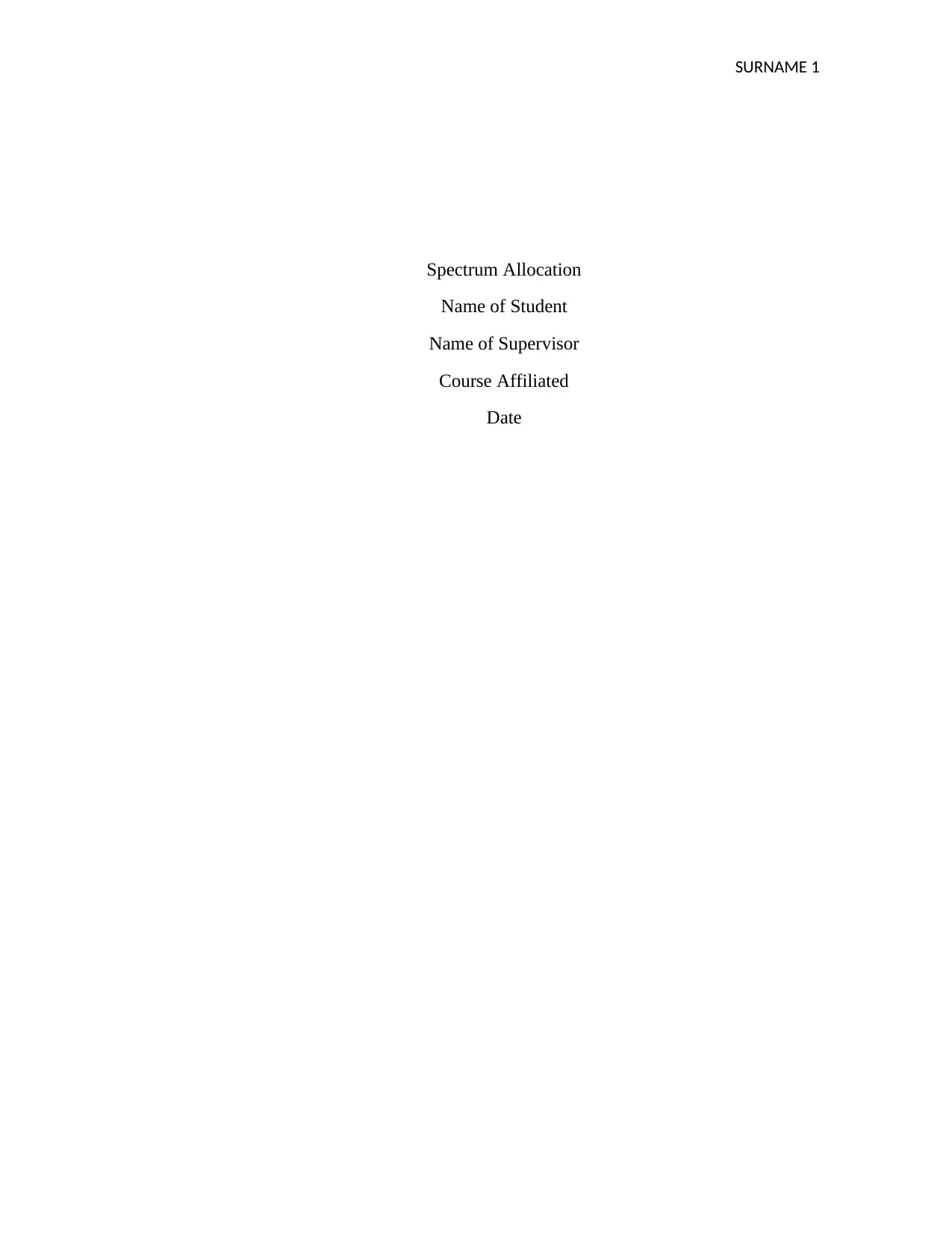
SURNAME 1
Spectrum Allocation
Name of Student
Name of Supervisor
Course Affiliated
Date
Spectrum Allocation
Name of Student
Name of Supervisor
Course Affiliated
Date
Paraphrase This Document
Need a fresh take? Get an instant paraphrase of this document with our AI Paraphraser
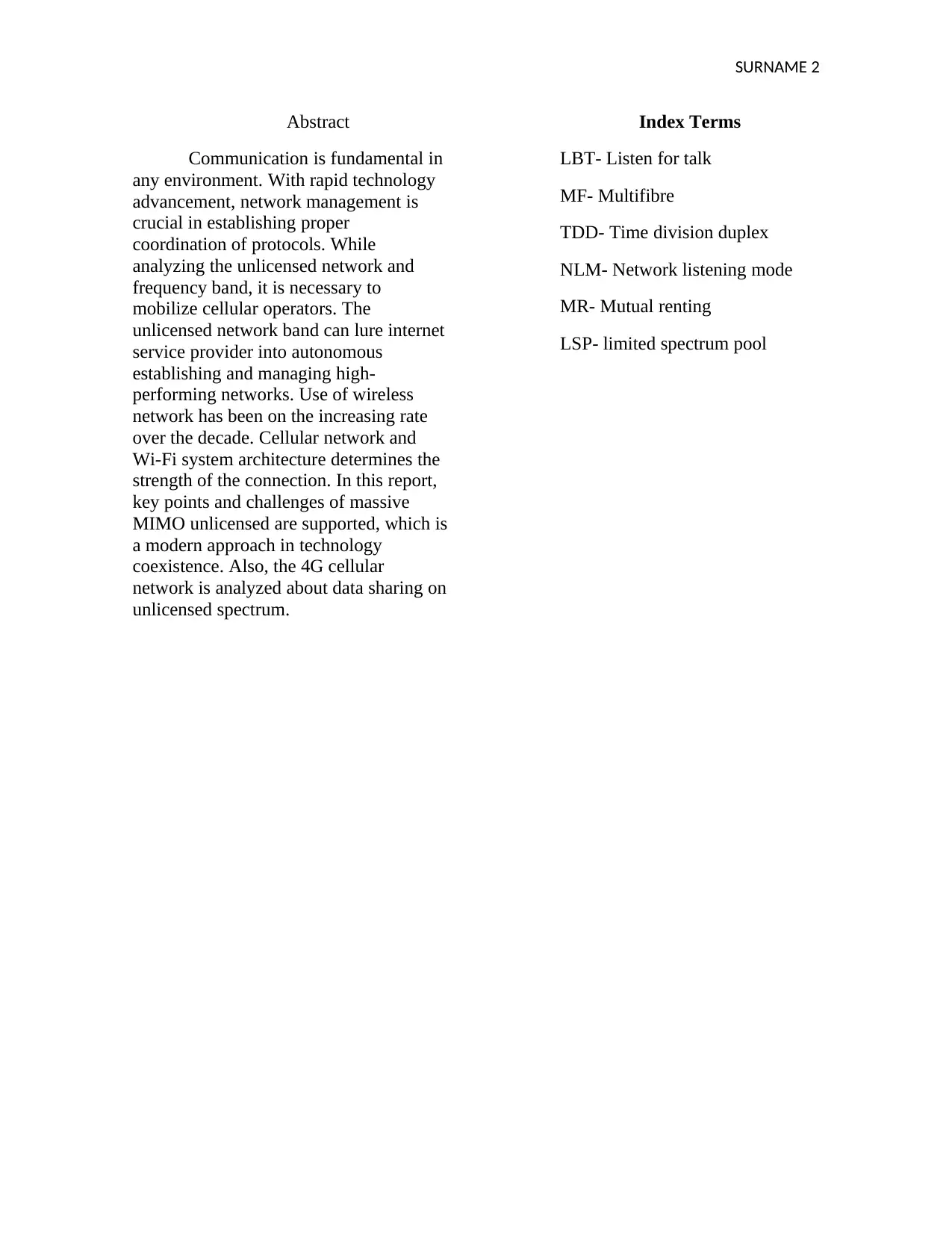
SURNAME 2
Abstract
Communication is fundamental in
any environment. With rapid technology
advancement, network management is
crucial in establishing proper
coordination of protocols. While
analyzing the unlicensed network and
frequency band, it is necessary to
mobilize cellular operators. The
unlicensed network band can lure internet
service provider into autonomous
establishing and managing high-
performing networks. Use of wireless
network has been on the increasing rate
over the decade. Cellular network and
Wi-Fi system architecture determines the
strength of the connection. In this report,
key points and challenges of massive
MIMO unlicensed are supported, which is
a modern approach in technology
coexistence. Also, the 4G cellular
network is analyzed about data sharing on
unlicensed spectrum.
Index Terms
LBT- Listen for talk
MF- Multifibre
TDD- Time division duplex
NLM- Network listening mode
MR- Mutual renting
LSP- limited spectrum pool
Abstract
Communication is fundamental in
any environment. With rapid technology
advancement, network management is
crucial in establishing proper
coordination of protocols. While
analyzing the unlicensed network and
frequency band, it is necessary to
mobilize cellular operators. The
unlicensed network band can lure internet
service provider into autonomous
establishing and managing high-
performing networks. Use of wireless
network has been on the increasing rate
over the decade. Cellular network and
Wi-Fi system architecture determines the
strength of the connection. In this report,
key points and challenges of massive
MIMO unlicensed are supported, which is
a modern approach in technology
coexistence. Also, the 4G cellular
network is analyzed about data sharing on
unlicensed spectrum.
Index Terms
LBT- Listen for talk
MF- Multifibre
TDD- Time division duplex
NLM- Network listening mode
MR- Mutual renting
LSP- limited spectrum pool
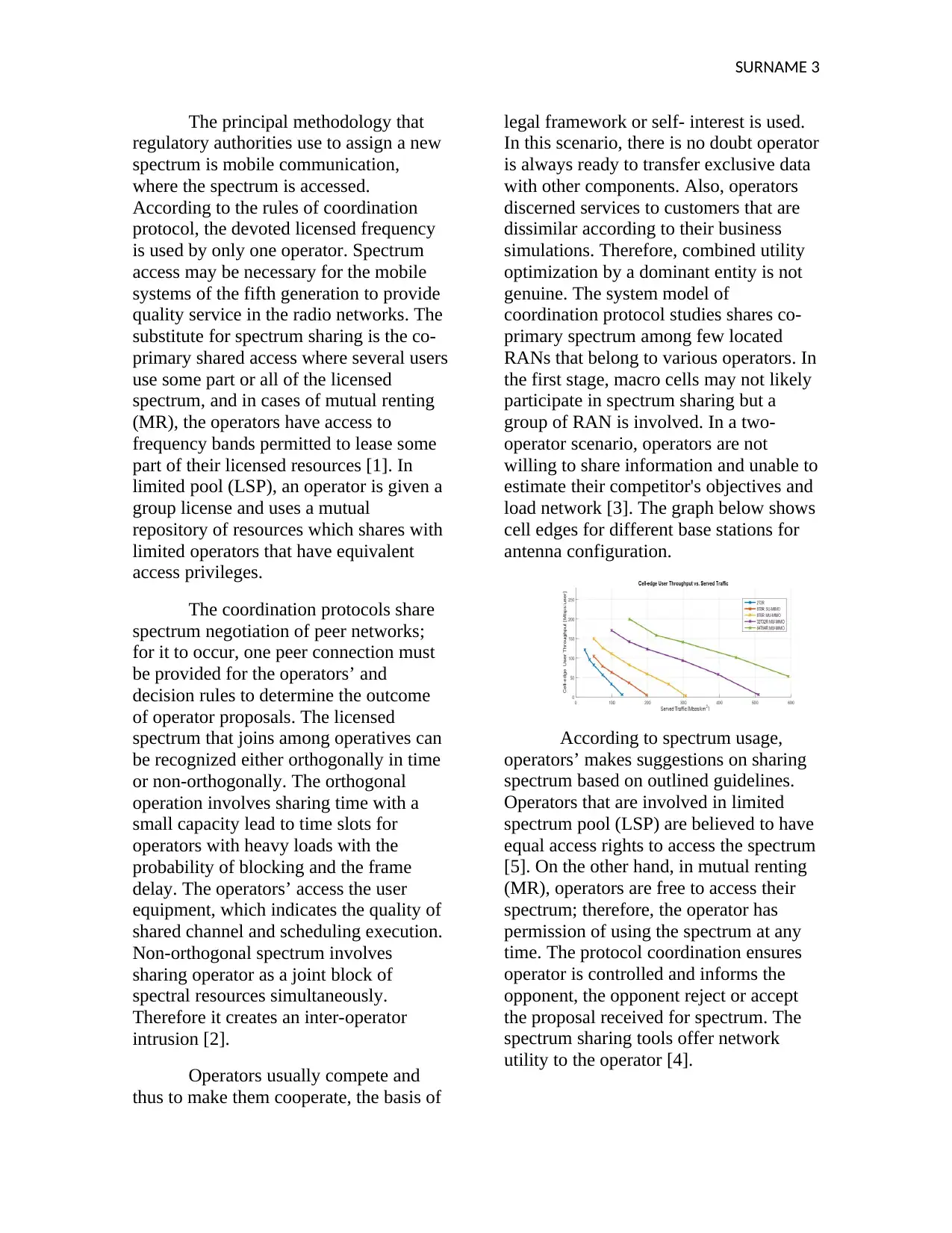
SURNAME 3
The principal methodology that
regulatory authorities use to assign a new
spectrum is mobile communication,
where the spectrum is accessed.
According to the rules of coordination
protocol, the devoted licensed frequency
is used by only one operator. Spectrum
access may be necessary for the mobile
systems of the fifth generation to provide
quality service in the radio networks. The
substitute for spectrum sharing is the co-
primary shared access where several users
use some part or all of the licensed
spectrum, and in cases of mutual renting
(MR), the operators have access to
frequency bands permitted to lease some
part of their licensed resources [1]. In
limited pool (LSP), an operator is given a
group license and uses a mutual
repository of resources which shares with
limited operators that have equivalent
access privileges.
The coordination protocols share
spectrum negotiation of peer networks;
for it to occur, one peer connection must
be provided for the operators’ and
decision rules to determine the outcome
of operator proposals. The licensed
spectrum that joins among operatives can
be recognized either orthogonally in time
or non-orthogonally. The orthogonal
operation involves sharing time with a
small capacity lead to time slots for
operators with heavy loads with the
probability of blocking and the frame
delay. The operators’ access the user
equipment, which indicates the quality of
shared channel and scheduling execution.
Non-orthogonal spectrum involves
sharing operator as a joint block of
spectral resources simultaneously.
Therefore it creates an inter-operator
intrusion [2].
Operators usually compete and
thus to make them cooperate, the basis of
legal framework or self- interest is used.
In this scenario, there is no doubt operator
is always ready to transfer exclusive data
with other components. Also, operators
discerned services to customers that are
dissimilar according to their business
simulations. Therefore, combined utility
optimization by a dominant entity is not
genuine. The system model of
coordination protocol studies shares co-
primary spectrum among few located
RANs that belong to various operators. In
the first stage, macro cells may not likely
participate in spectrum sharing but a
group of RAN is involved. In a two-
operator scenario, operators are not
willing to share information and unable to
estimate their competitor's objectives and
load network [3]. The graph below shows
cell edges for different base stations for
antenna configuration.
According to spectrum usage,
operators’ makes suggestions on sharing
spectrum based on outlined guidelines.
Operators that are involved in limited
spectrum pool (LSP) are believed to have
equal access rights to access the spectrum
[5]. On the other hand, in mutual renting
(MR), operators are free to access their
spectrum; therefore, the operator has
permission of using the spectrum at any
time. The protocol coordination ensures
operator is controlled and informs the
opponent, the opponent reject or accept
the proposal received for spectrum. The
spectrum sharing tools offer network
utility to the operator [4].
The principal methodology that
regulatory authorities use to assign a new
spectrum is mobile communication,
where the spectrum is accessed.
According to the rules of coordination
protocol, the devoted licensed frequency
is used by only one operator. Spectrum
access may be necessary for the mobile
systems of the fifth generation to provide
quality service in the radio networks. The
substitute for spectrum sharing is the co-
primary shared access where several users
use some part or all of the licensed
spectrum, and in cases of mutual renting
(MR), the operators have access to
frequency bands permitted to lease some
part of their licensed resources [1]. In
limited pool (LSP), an operator is given a
group license and uses a mutual
repository of resources which shares with
limited operators that have equivalent
access privileges.
The coordination protocols share
spectrum negotiation of peer networks;
for it to occur, one peer connection must
be provided for the operators’ and
decision rules to determine the outcome
of operator proposals. The licensed
spectrum that joins among operatives can
be recognized either orthogonally in time
or non-orthogonally. The orthogonal
operation involves sharing time with a
small capacity lead to time slots for
operators with heavy loads with the
probability of blocking and the frame
delay. The operators’ access the user
equipment, which indicates the quality of
shared channel and scheduling execution.
Non-orthogonal spectrum involves
sharing operator as a joint block of
spectral resources simultaneously.
Therefore it creates an inter-operator
intrusion [2].
Operators usually compete and
thus to make them cooperate, the basis of
legal framework or self- interest is used.
In this scenario, there is no doubt operator
is always ready to transfer exclusive data
with other components. Also, operators
discerned services to customers that are
dissimilar according to their business
simulations. Therefore, combined utility
optimization by a dominant entity is not
genuine. The system model of
coordination protocol studies shares co-
primary spectrum among few located
RANs that belong to various operators. In
the first stage, macro cells may not likely
participate in spectrum sharing but a
group of RAN is involved. In a two-
operator scenario, operators are not
willing to share information and unable to
estimate their competitor's objectives and
load network [3]. The graph below shows
cell edges for different base stations for
antenna configuration.
According to spectrum usage,
operators’ makes suggestions on sharing
spectrum based on outlined guidelines.
Operators that are involved in limited
spectrum pool (LSP) are believed to have
equal access rights to access the spectrum
[5]. On the other hand, in mutual renting
(MR), operators are free to access their
spectrum; therefore, the operator has
permission of using the spectrum at any
time. The protocol coordination ensures
operator is controlled and informs the
opponent, the opponent reject or accept
the proposal received for spectrum. The
spectrum sharing tools offer network
utility to the operator [4].
⊘ This is a preview!⊘
Do you want full access?
Subscribe today to unlock all pages.

Trusted by 1+ million students worldwide
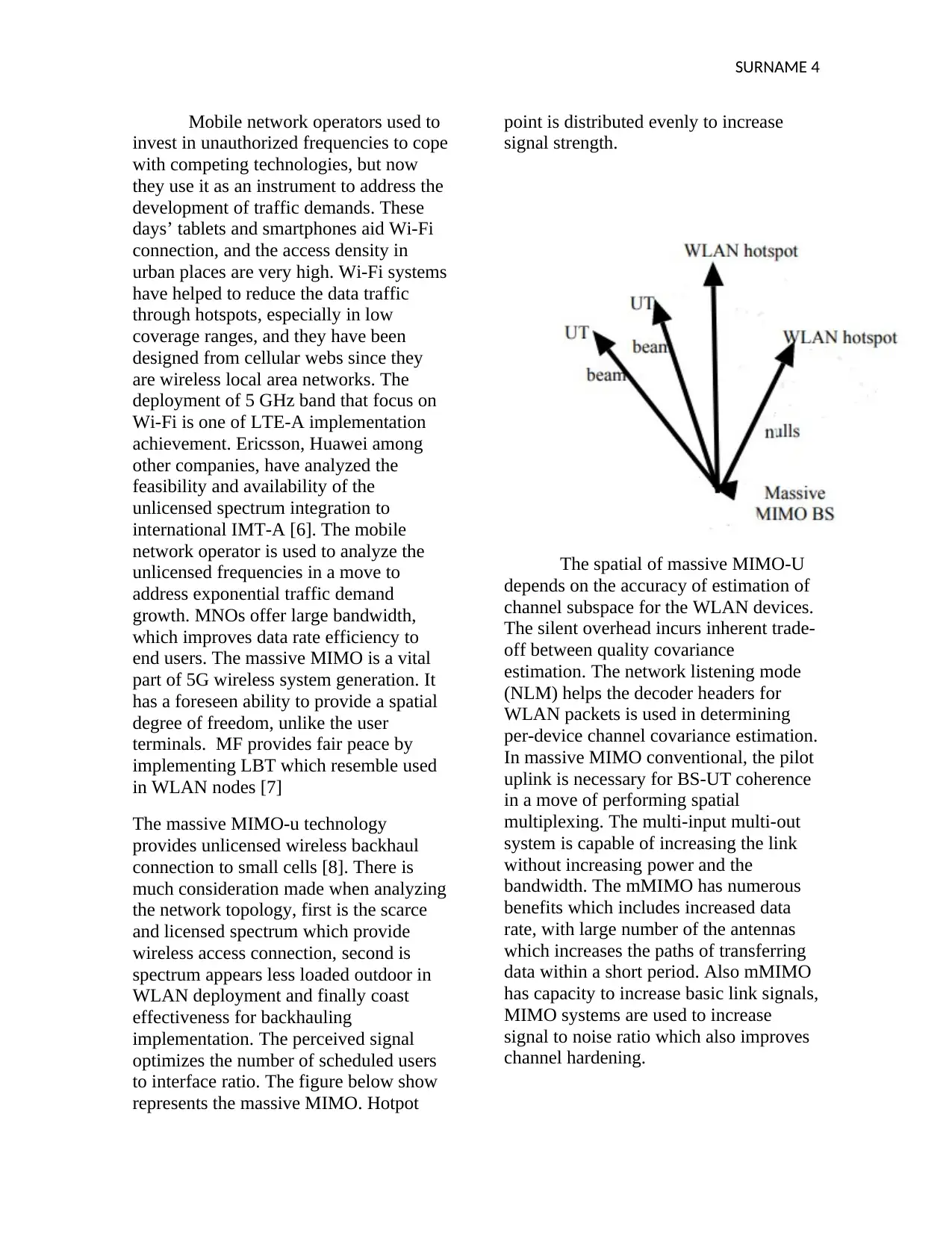
SURNAME 4
Mobile network operators used to
invest in unauthorized frequencies to cope
with competing technologies, but now
they use it as an instrument to address the
development of traffic demands. These
days’ tablets and smartphones aid Wi-Fi
connection, and the access density in
urban places are very high. Wi-Fi systems
have helped to reduce the data traffic
through hotspots, especially in low
coverage ranges, and they have been
designed from cellular webs since they
are wireless local area networks. The
deployment of 5 GHz band that focus on
Wi-Fi is one of LTE-A implementation
achievement. Ericsson, Huawei among
other companies, have analyzed the
feasibility and availability of the
unlicensed spectrum integration to
international IMT-A [6]. The mobile
network operator is used to analyze the
unlicensed frequencies in a move to
address exponential traffic demand
growth. MNOs offer large bandwidth,
which improves data rate efficiency to
end users. The massive MIMO is a vital
part of 5G wireless system generation. It
has a foreseen ability to provide a spatial
degree of freedom, unlike the user
terminals. MF provides fair peace by
implementing LBT which resemble used
in WLAN nodes [7]
The massive MIMO-u technology
provides unlicensed wireless backhaul
connection to small cells [8]. There is
much consideration made when analyzing
the network topology, first is the scarce
and licensed spectrum which provide
wireless access connection, second is
spectrum appears less loaded outdoor in
WLAN deployment and finally coast
effectiveness for backhauling
implementation. The perceived signal
optimizes the number of scheduled users
to interface ratio. The figure below show
represents the massive MIMO. Hotpot
point is distributed evenly to increase
signal strength.
The spatial of massive MIMO-U
depends on the accuracy of estimation of
channel subspace for the WLAN devices.
The silent overhead incurs inherent trade-
off between quality covariance
estimation. The network listening mode
(NLM) helps the decoder headers for
WLAN packets is used in determining
per-device channel covariance estimation.
In massive MIMO conventional, the pilot
uplink is necessary for BS-UT coherence
in a move of performing spatial
multiplexing. The multi-input multi-out
system is capable of increasing the link
without increasing power and the
bandwidth. The mMIMO has numerous
benefits which includes increased data
rate, with large number of the antennas
which increases the paths of transferring
data within a short period. Also mMIMO
has capacity to increase basic link signals,
MIMO systems are used to increase
signal to noise ratio which also improves
channel hardening.
Mobile network operators used to
invest in unauthorized frequencies to cope
with competing technologies, but now
they use it as an instrument to address the
development of traffic demands. These
days’ tablets and smartphones aid Wi-Fi
connection, and the access density in
urban places are very high. Wi-Fi systems
have helped to reduce the data traffic
through hotspots, especially in low
coverage ranges, and they have been
designed from cellular webs since they
are wireless local area networks. The
deployment of 5 GHz band that focus on
Wi-Fi is one of LTE-A implementation
achievement. Ericsson, Huawei among
other companies, have analyzed the
feasibility and availability of the
unlicensed spectrum integration to
international IMT-A [6]. The mobile
network operator is used to analyze the
unlicensed frequencies in a move to
address exponential traffic demand
growth. MNOs offer large bandwidth,
which improves data rate efficiency to
end users. The massive MIMO is a vital
part of 5G wireless system generation. It
has a foreseen ability to provide a spatial
degree of freedom, unlike the user
terminals. MF provides fair peace by
implementing LBT which resemble used
in WLAN nodes [7]
The massive MIMO-u technology
provides unlicensed wireless backhaul
connection to small cells [8]. There is
much consideration made when analyzing
the network topology, first is the scarce
and licensed spectrum which provide
wireless access connection, second is
spectrum appears less loaded outdoor in
WLAN deployment and finally coast
effectiveness for backhauling
implementation. The perceived signal
optimizes the number of scheduled users
to interface ratio. The figure below show
represents the massive MIMO. Hotpot
point is distributed evenly to increase
signal strength.
The spatial of massive MIMO-U
depends on the accuracy of estimation of
channel subspace for the WLAN devices.
The silent overhead incurs inherent trade-
off between quality covariance
estimation. The network listening mode
(NLM) helps the decoder headers for
WLAN packets is used in determining
per-device channel covariance estimation.
In massive MIMO conventional, the pilot
uplink is necessary for BS-UT coherence
in a move of performing spatial
multiplexing. The multi-input multi-out
system is capable of increasing the link
without increasing power and the
bandwidth. The mMIMO has numerous
benefits which includes increased data
rate, with large number of the antennas
which increases the paths of transferring
data within a short period. Also mMIMO
has capacity to increase basic link signals,
MIMO systems are used to increase
signal to noise ratio which also improves
channel hardening.
Paraphrase This Document
Need a fresh take? Get an instant paraphrase of this document with our AI Paraphraser
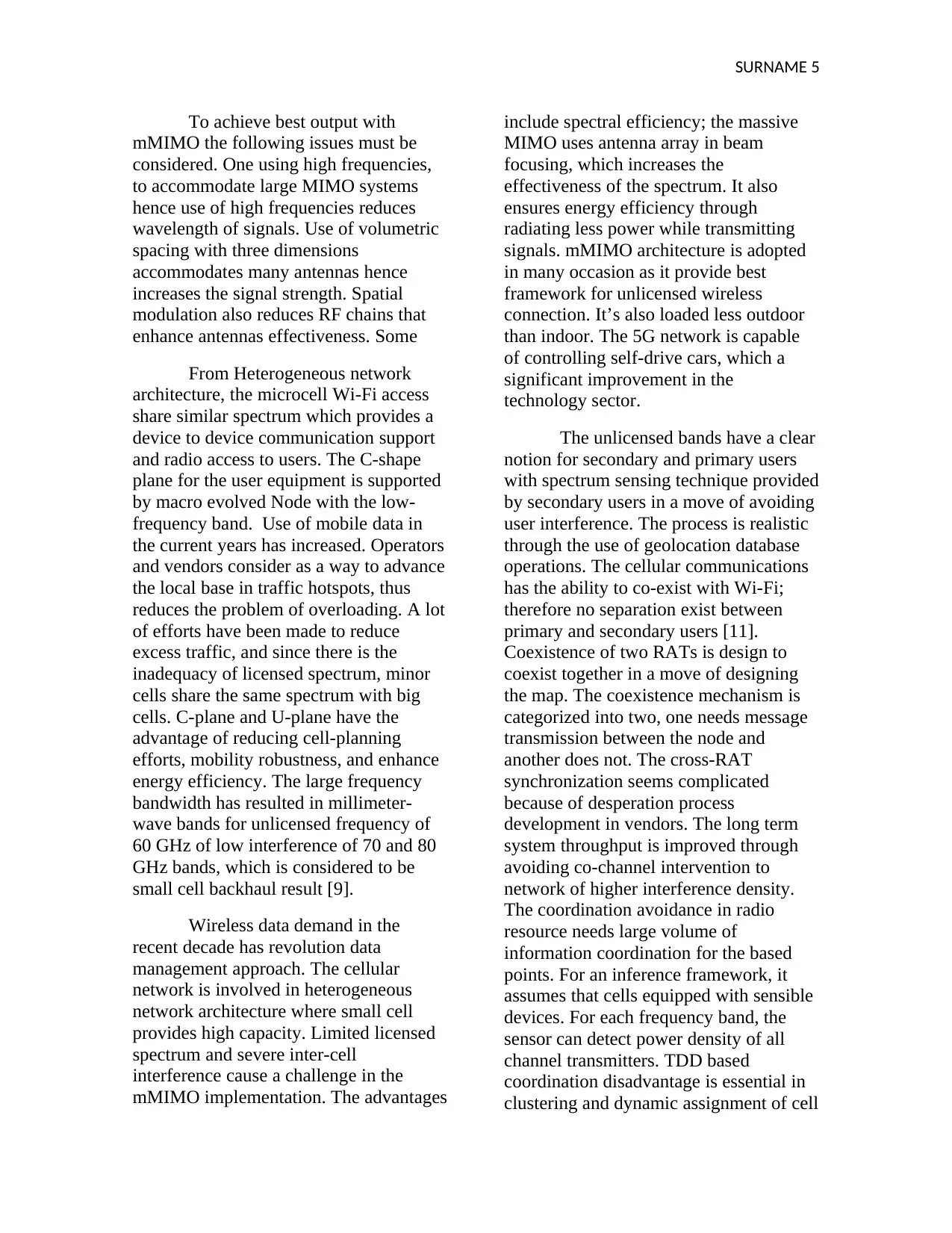
SURNAME 5
To achieve best output with
mMIMO the following issues must be
considered. One using high frequencies,
to accommodate large MIMO systems
hence use of high frequencies reduces
wavelength of signals. Use of volumetric
spacing with three dimensions
accommodates many antennas hence
increases the signal strength. Spatial
modulation also reduces RF chains that
enhance antennas effectiveness. Some
From Heterogeneous network
architecture, the microcell Wi-Fi access
share similar spectrum which provides a
device to device communication support
and radio access to users. The C-shape
plane for the user equipment is supported
by macro evolved Node with the low-
frequency band. Use of mobile data in
the current years has increased. Operators
and vendors consider as a way to advance
the local base in traffic hotspots, thus
reduces the problem of overloading. A lot
of efforts have been made to reduce
excess traffic, and since there is the
inadequacy of licensed spectrum, minor
cells share the same spectrum with big
cells. C-plane and U-plane have the
advantage of reducing cell-planning
efforts, mobility robustness, and enhance
energy efficiency. The large frequency
bandwidth has resulted in millimeter-
wave bands for unlicensed frequency of
60 GHz of low interference of 70 and 80
GHz bands, which is considered to be
small cell backhaul result [9].
Wireless data demand in the
recent decade has revolution data
management approach. The cellular
network is involved in heterogeneous
network architecture where small cell
provides high capacity. Limited licensed
spectrum and severe inter-cell
interference cause a challenge in the
mMIMO implementation. The advantages
include spectral efficiency; the massive
MIMO uses antenna array in beam
focusing, which increases the
effectiveness of the spectrum. It also
ensures energy efficiency through
radiating less power while transmitting
signals. mMIMO architecture is adopted
in many occasion as it provide best
framework for unlicensed wireless
connection. It’s also loaded less outdoor
than indoor. The 5G network is capable
of controlling self-drive cars, which a
significant improvement in the
technology sector.
The unlicensed bands have a clear
notion for secondary and primary users
with spectrum sensing technique provided
by secondary users in a move of avoiding
user interference. The process is realistic
through the use of geolocation database
operations. The cellular communications
has the ability to co-exist with Wi-Fi;
therefore no separation exist between
primary and secondary users [11].
Coexistence of two RATs is design to
coexist together in a move of designing
the map. The coexistence mechanism is
categorized into two, one needs message
transmission between the node and
another does not. The cross-RAT
synchronization seems complicated
because of desperation process
development in vendors. The long term
system throughput is improved through
avoiding co-channel intervention to
network of higher interference density.
The coordination avoidance in radio
resource needs large volume of
information coordination for the based
points. For an inference framework, it
assumes that cells equipped with sensible
devices. For each frequency band, the
sensor can detect power density of all
channel transmitters. TDD based
coordination disadvantage is essential in
clustering and dynamic assignment of cell
To achieve best output with
mMIMO the following issues must be
considered. One using high frequencies,
to accommodate large MIMO systems
hence use of high frequencies reduces
wavelength of signals. Use of volumetric
spacing with three dimensions
accommodates many antennas hence
increases the signal strength. Spatial
modulation also reduces RF chains that
enhance antennas effectiveness. Some
From Heterogeneous network
architecture, the microcell Wi-Fi access
share similar spectrum which provides a
device to device communication support
and radio access to users. The C-shape
plane for the user equipment is supported
by macro evolved Node with the low-
frequency band. Use of mobile data in
the current years has increased. Operators
and vendors consider as a way to advance
the local base in traffic hotspots, thus
reduces the problem of overloading. A lot
of efforts have been made to reduce
excess traffic, and since there is the
inadequacy of licensed spectrum, minor
cells share the same spectrum with big
cells. C-plane and U-plane have the
advantage of reducing cell-planning
efforts, mobility robustness, and enhance
energy efficiency. The large frequency
bandwidth has resulted in millimeter-
wave bands for unlicensed frequency of
60 GHz of low interference of 70 and 80
GHz bands, which is considered to be
small cell backhaul result [9].
Wireless data demand in the
recent decade has revolution data
management approach. The cellular
network is involved in heterogeneous
network architecture where small cell
provides high capacity. Limited licensed
spectrum and severe inter-cell
interference cause a challenge in the
mMIMO implementation. The advantages
include spectral efficiency; the massive
MIMO uses antenna array in beam
focusing, which increases the
effectiveness of the spectrum. It also
ensures energy efficiency through
radiating less power while transmitting
signals. mMIMO architecture is adopted
in many occasion as it provide best
framework for unlicensed wireless
connection. It’s also loaded less outdoor
than indoor. The 5G network is capable
of controlling self-drive cars, which a
significant improvement in the
technology sector.
The unlicensed bands have a clear
notion for secondary and primary users
with spectrum sensing technique provided
by secondary users in a move of avoiding
user interference. The process is realistic
through the use of geolocation database
operations. The cellular communications
has the ability to co-exist with Wi-Fi;
therefore no separation exist between
primary and secondary users [11].
Coexistence of two RATs is design to
coexist together in a move of designing
the map. The coexistence mechanism is
categorized into two, one needs message
transmission between the node and
another does not. The cross-RAT
synchronization seems complicated
because of desperation process
development in vendors. The long term
system throughput is improved through
avoiding co-channel intervention to
network of higher interference density.
The coordination avoidance in radio
resource needs large volume of
information coordination for the based
points. For an inference framework, it
assumes that cells equipped with sensible
devices. For each frequency band, the
sensor can detect power density of all
channel transmitters. TDD based
coordination disadvantage is essential in
clustering and dynamic assignment of cell
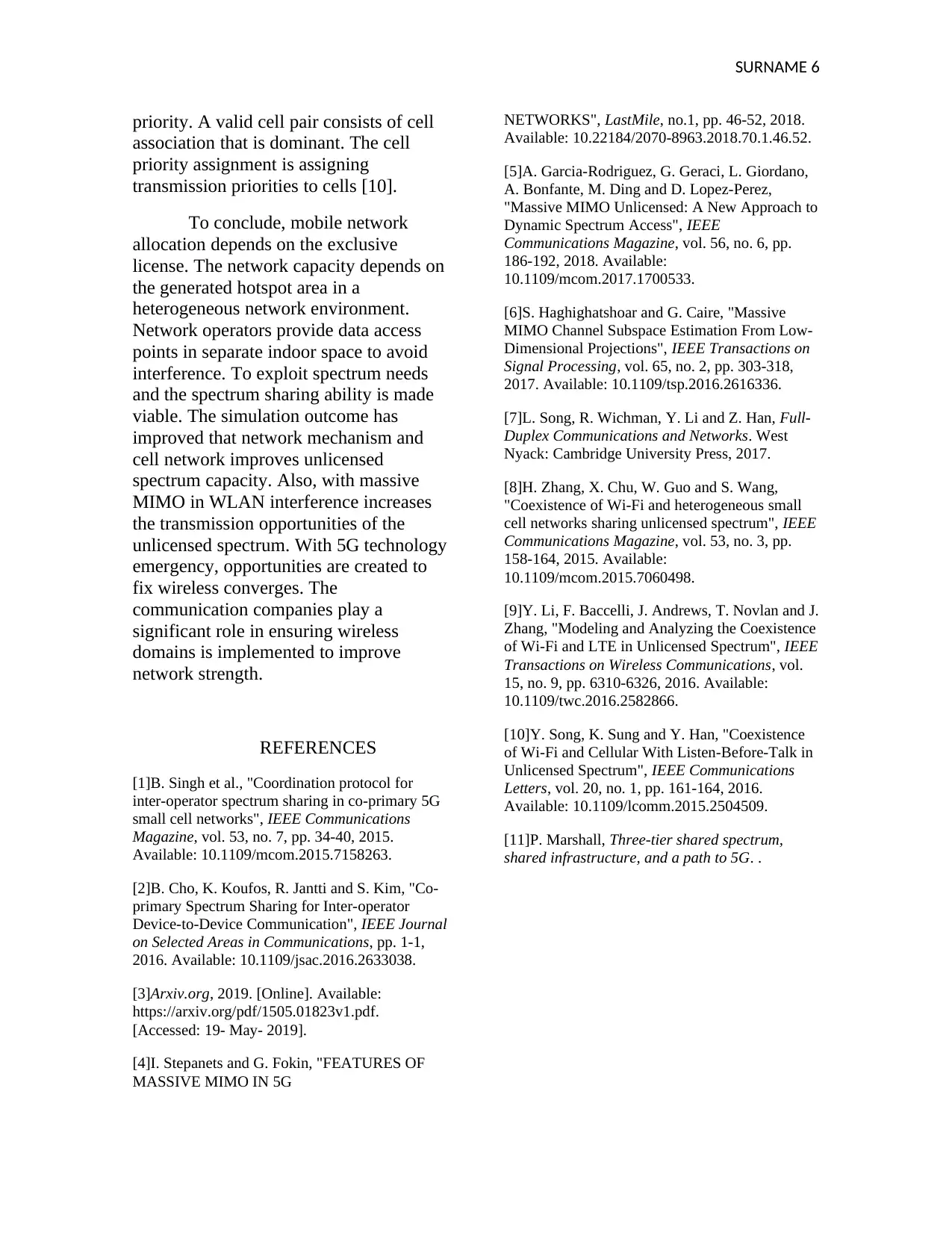
SURNAME 6
priority. A valid cell pair consists of cell
association that is dominant. The cell
priority assignment is assigning
transmission priorities to cells [10].
To conclude, mobile network
allocation depends on the exclusive
license. The network capacity depends on
the generated hotspot area in a
heterogeneous network environment.
Network operators provide data access
points in separate indoor space to avoid
interference. To exploit spectrum needs
and the spectrum sharing ability is made
viable. The simulation outcome has
improved that network mechanism and
cell network improves unlicensed
spectrum capacity. Also, with massive
MIMO in WLAN interference increases
the transmission opportunities of the
unlicensed spectrum. With 5G technology
emergency, opportunities are created to
fix wireless converges. The
communication companies play a
significant role in ensuring wireless
domains is implemented to improve
network strength.
REFERENCES
[1]B. Singh et al., "Coordination protocol for
inter-operator spectrum sharing in co-primary 5G
small cell networks", IEEE Communications
Magazine, vol. 53, no. 7, pp. 34-40, 2015.
Available: 10.1109/mcom.2015.7158263.
[2]B. Cho, K. Koufos, R. Jantti and S. Kim, "Co-
primary Spectrum Sharing for Inter-operator
Device-to-Device Communication", IEEE Journal
on Selected Areas in Communications, pp. 1-1,
2016. Available: 10.1109/jsac.2016.2633038.
[3]Arxiv.org, 2019. [Online]. Available:
https://arxiv.org/pdf/1505.01823v1.pdf.
[Accessed: 19- May- 2019].
[4]I. Stepanets and G. Fokin, "FEATURES OF
MASSIVE MIMO IN 5G
NETWORKS", LastMile, no.1, pp. 46-52, 2018.
Available: 10.22184/2070-8963.2018.70.1.46.52.
[5]A. Garcia-Rodriguez, G. Geraci, L. Giordano,
A. Bonfante, M. Ding and D. Lopez-Perez,
"Massive MIMO Unlicensed: A New Approach to
Dynamic Spectrum Access", IEEE
Communications Magazine, vol. 56, no. 6, pp.
186-192, 2018. Available:
10.1109/mcom.2017.1700533.
[6]S. Haghighatshoar and G. Caire, "Massive
MIMO Channel Subspace Estimation From Low-
Dimensional Projections", IEEE Transactions on
Signal Processing, vol. 65, no. 2, pp. 303-318,
2017. Available: 10.1109/tsp.2016.2616336.
[7]L. Song, R. Wichman, Y. Li and Z. Han, Full-
Duplex Communications and Networks. West
Nyack: Cambridge University Press, 2017.
[8]H. Zhang, X. Chu, W. Guo and S. Wang,
"Coexistence of Wi-Fi and heterogeneous small
cell networks sharing unlicensed spectrum", IEEE
Communications Magazine, vol. 53, no. 3, pp.
158-164, 2015. Available:
10.1109/mcom.2015.7060498.
[9]Y. Li, F. Baccelli, J. Andrews, T. Novlan and J.
Zhang, "Modeling and Analyzing the Coexistence
of Wi-Fi and LTE in Unlicensed Spectrum", IEEE
Transactions on Wireless Communications, vol.
15, no. 9, pp. 6310-6326, 2016. Available:
10.1109/twc.2016.2582866.
[10]Y. Song, K. Sung and Y. Han, "Coexistence
of Wi-Fi and Cellular With Listen-Before-Talk in
Unlicensed Spectrum", IEEE Communications
Letters, vol. 20, no. 1, pp. 161-164, 2016.
Available: 10.1109/lcomm.2015.2504509.
[11]P. Marshall, Three-tier shared spectrum,
shared infrastructure, and a path to 5G. .
priority. A valid cell pair consists of cell
association that is dominant. The cell
priority assignment is assigning
transmission priorities to cells [10].
To conclude, mobile network
allocation depends on the exclusive
license. The network capacity depends on
the generated hotspot area in a
heterogeneous network environment.
Network operators provide data access
points in separate indoor space to avoid
interference. To exploit spectrum needs
and the spectrum sharing ability is made
viable. The simulation outcome has
improved that network mechanism and
cell network improves unlicensed
spectrum capacity. Also, with massive
MIMO in WLAN interference increases
the transmission opportunities of the
unlicensed spectrum. With 5G technology
emergency, opportunities are created to
fix wireless converges. The
communication companies play a
significant role in ensuring wireless
domains is implemented to improve
network strength.
REFERENCES
[1]B. Singh et al., "Coordination protocol for
inter-operator spectrum sharing in co-primary 5G
small cell networks", IEEE Communications
Magazine, vol. 53, no. 7, pp. 34-40, 2015.
Available: 10.1109/mcom.2015.7158263.
[2]B. Cho, K. Koufos, R. Jantti and S. Kim, "Co-
primary Spectrum Sharing for Inter-operator
Device-to-Device Communication", IEEE Journal
on Selected Areas in Communications, pp. 1-1,
2016. Available: 10.1109/jsac.2016.2633038.
[3]Arxiv.org, 2019. [Online]. Available:
https://arxiv.org/pdf/1505.01823v1.pdf.
[Accessed: 19- May- 2019].
[4]I. Stepanets and G. Fokin, "FEATURES OF
MASSIVE MIMO IN 5G
NETWORKS", LastMile, no.1, pp. 46-52, 2018.
Available: 10.22184/2070-8963.2018.70.1.46.52.
[5]A. Garcia-Rodriguez, G. Geraci, L. Giordano,
A. Bonfante, M. Ding and D. Lopez-Perez,
"Massive MIMO Unlicensed: A New Approach to
Dynamic Spectrum Access", IEEE
Communications Magazine, vol. 56, no. 6, pp.
186-192, 2018. Available:
10.1109/mcom.2017.1700533.
[6]S. Haghighatshoar and G. Caire, "Massive
MIMO Channel Subspace Estimation From Low-
Dimensional Projections", IEEE Transactions on
Signal Processing, vol. 65, no. 2, pp. 303-318,
2017. Available: 10.1109/tsp.2016.2616336.
[7]L. Song, R. Wichman, Y. Li and Z. Han, Full-
Duplex Communications and Networks. West
Nyack: Cambridge University Press, 2017.
[8]H. Zhang, X. Chu, W. Guo and S. Wang,
"Coexistence of Wi-Fi and heterogeneous small
cell networks sharing unlicensed spectrum", IEEE
Communications Magazine, vol. 53, no. 3, pp.
158-164, 2015. Available:
10.1109/mcom.2015.7060498.
[9]Y. Li, F. Baccelli, J. Andrews, T. Novlan and J.
Zhang, "Modeling and Analyzing the Coexistence
of Wi-Fi and LTE in Unlicensed Spectrum", IEEE
Transactions on Wireless Communications, vol.
15, no. 9, pp. 6310-6326, 2016. Available:
10.1109/twc.2016.2582866.
[10]Y. Song, K. Sung and Y. Han, "Coexistence
of Wi-Fi and Cellular With Listen-Before-Talk in
Unlicensed Spectrum", IEEE Communications
Letters, vol. 20, no. 1, pp. 161-164, 2016.
Available: 10.1109/lcomm.2015.2504509.
[11]P. Marshall, Three-tier shared spectrum,
shared infrastructure, and a path to 5G. .
⊘ This is a preview!⊘
Do you want full access?
Subscribe today to unlock all pages.

Trusted by 1+ million students worldwide
1 out of 6
Your All-in-One AI-Powered Toolkit for Academic Success.
+13062052269
info@desklib.com
Available 24*7 on WhatsApp / Email
![[object Object]](/_next/static/media/star-bottom.7253800d.svg)
Unlock your academic potential
Copyright © 2020–2025 A2Z Services. All Rights Reserved. Developed and managed by ZUCOL.
